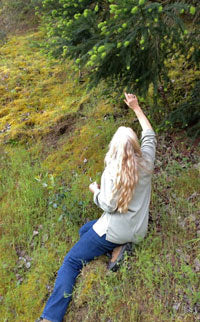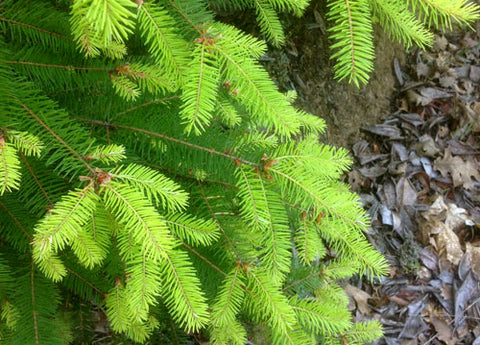 When you spend lots of time wandering about in the woods, the odd things you find yourself doing there sort of sneak up on you. Many many springs ago I had taken a chef for a hike about the woods. I’d sort of forgotten them when a voice yelled “what the hell are you chewing”. I turned and realized I had fir tip bits stuck around my lips. Uh oh, trust me, no one was doing that then. Plucking and tasting the delicate apple green little tips from one tree and then another, had always been a private pleasure. Each Douglas fir tree has a slightly different flavor. One may taste like Meyer lemon peel or tangerine peel. Another might taste like peach skin, and then another may be a sharp resiny green flavor. You can taste the wondrous genetic variation in these surprisingly delicious wild trees. The same grazing tastiness can be done with many spruces in the lands blessed with spruce trees and their brush like tips.
When you spend lots of time wandering about in the woods, the odd things you find yourself doing there sort of sneak up on you. Many many springs ago I had taken a chef for a hike about the woods. I’d sort of forgotten them when a voice yelled “what the hell are you chewing”. I turned and realized I had fir tip bits stuck around my lips. Uh oh, trust me, no one was doing that then. Plucking and tasting the delicate apple green little tips from one tree and then another, had always been a private pleasure. Each Douglas fir tree has a slightly different flavor. One may taste like Meyer lemon peel or tangerine peel. Another might taste like peach skin, and then another may be a sharp resiny green flavor. You can taste the wondrous genetic variation in these surprisingly delicious wild trees. The same grazing tastiness can be done with many spruces in the lands blessed with spruce trees and their brush like tips.
I feel a bit less crazy now and more than vindicated after a wave of intrepid chefs across the country and even Europe have welcomed the citrus bright and foresty flavor into a range of dishes from fois to desserts. You can also now belly up to our beautiful western tree in cocktails, beers and beautiful eau de vies.
Although Douglas fir trees are native to the west, they have been propagated widely as ornamental and as a lumber trees. They can now be found throughout the East, Midwest and are even found widely planted in Europe. Finding spruce trees is a similar situation. Both of these trees are either native or planted widely. Our beloved pagan tree worshipping tradition has made Christmas tree farms a handy source of both of these trees. If you explain to the farmer that you just want to pinch the side tips off, they may welcome you with genuine gratitude since this is a form of pruning that makes the trees nice and bushy. Never pinch or cut off the tip on the top of the tree or harvest more than maybe a fifth of each tree’s new tips. You can take far more of the mature needles if this is what you’re going to use. Just harvest a branch and strip the needles off.
The citrus flavor of many of these fir and spruce tips reflects the vitamin C rich content. The flavor remains as the tips mature into the deep green needles we know all year round. The texture changes however, from the very tender pale tips that can be tossed into a salad to the toughened deep green mature needles. If you’ve come to love tender fir tips, don’t give up. The hardened mature needles have magnificent flavor that I find even more complex than young tips. You just extract the flavor differently. Oil, vodka, and water are all fine vehicles for the transforming a mighty tree into uniquely delicious treats.

Here’re a few ideas. With all of these, begin with the tips or regular needles that you have stripped off the stems.
Douglas Fir Oil
In a blender, put 2 cups of a fine neutral flavored oil like almond oil with ¾ C fir needles . Hit “liquefy”. In 1-2 minutes the oil will be a gorgeous emerald green. Put this in a jar and into the refrigerator for 24 hours. Take out and pour this mess into a sieve over bowl. Let it just sit as it warms to room temperature. After a couple hours, press the green goop in the sieve to extract all the oil possible. Put a paper coffee filter in a funnel and pour the sieved oil mixture into the paper filter. Let drain through a filter. This will go slowly and can take as much as 24 hours. The beautiful clear green oil should be kept in the refrigerator.
Use this oil for: Dotting or drizzling on cooked fish, game like venison, duck and even plain chicken.
Douglas Fir Tea
This simple popular tea requires just a tablespoon of needles in 1 ½ C boiling water. Strain into a mug after steeping for 2 minutes. Add honey if you wish. This is a nice ice tea as well.
Fir or Spruce Syrup:
This syrup is a great treat for everything from waffles to cocktails.
1 C fir or spruce needles or tips
1 C sugar
2 T light corn syrup
Put the fir or spruce tips or needles into a food processor. Pulse until very finely chopped.
In a saucepan put sugar, corn syrup and 1/3 C plus 2 T water. Stir and bring to a boil. Boil for one minute then add the chopped needles. Remove for the heat. Steep for 3-4 hours. Strain through a fine sieve. Discard the green goop in strainer. Put in a jar and keep refrigerated.
Use for: Waffles, pancakes or biscuits of course. This marvelous syrup is also ideal to use as the sweetener in recipes for ice cream, sorbet, panne cotta, or as a secret ingredient for some of the great cocktails below.
Fir or Spruce Vodka
What could be simpler? Put 1 cup fir or spruce needles into a blender with a half or 3/4 of a 750 ML bottle of vodka, as much as you can get in a blender. Hit “liquefy” and blend for 2 minutes. Pour this mixture and the balance of the vodka bottle into a large jar and put in the refrigerator for two days. Give it a little shake from time to time. Strain contents through a fine sieve and return to the bottle. I like to keep this in the freezer. The fir or spruce flavor is somewhat perishable. It benefits from being kept cold.
Douglas Fir Gimlet
This is my absolute favorite. It gets a double dose of fir from these ingredients:
1 1/2oz Douglas Fir infused vodka
½ oz lime juice
Heaping teaspoon of Douglas fir syrup
Chill a small cocktail glass. Fill cocktail shaker with cubed ice. Let this sit for a minute. Pour in all ingredients. Shake vigorously for as long as you can stand. Remove glass from the freezer and rub a cut lime around the rim. Strain into the chilled glass.
Douglas Fir Rickey
Chill a nice tall glass. The fir flavor makes this amazingly refreshing in hot weather.
1 ½ oz fir vodka
½ + oz lime juice
Club soda
Fill chill glass with ice. Rub lime section around the glass rim. Add the first two ingredients and pour club soda over the top. You can toss the lime you squeezed in too. Stir gently.
Douglas Fir Lime Collins
Make the same drink as above but add a heaping teaspoon of the Douglas fir syrup to this before you stir. You can make this a little more traditional by using lemon in place of the lime.
